On the track of Bernardino Luini in Lombardy
In the blog looking at the history of the Milan to Monza railway. I came across the church of San Martino and the story of Bernardino Luini’s frescoes and how they ended up in the Louvre, Bernardino Luini worked extensively in Lombardy and Ticino and aside from his works in galleries, many can still be seen in their original locations. In 1523 Luini was at Saronno, a small town near to Milan, on the way to Como, which contains a large pilgrimage church, II Santuario della Vergine. Saronno is famous its macarons, liqueur and as the last home of car and engine manufacturer Isotta Fraschini, but the church is a hidden gem and well worth seeing.
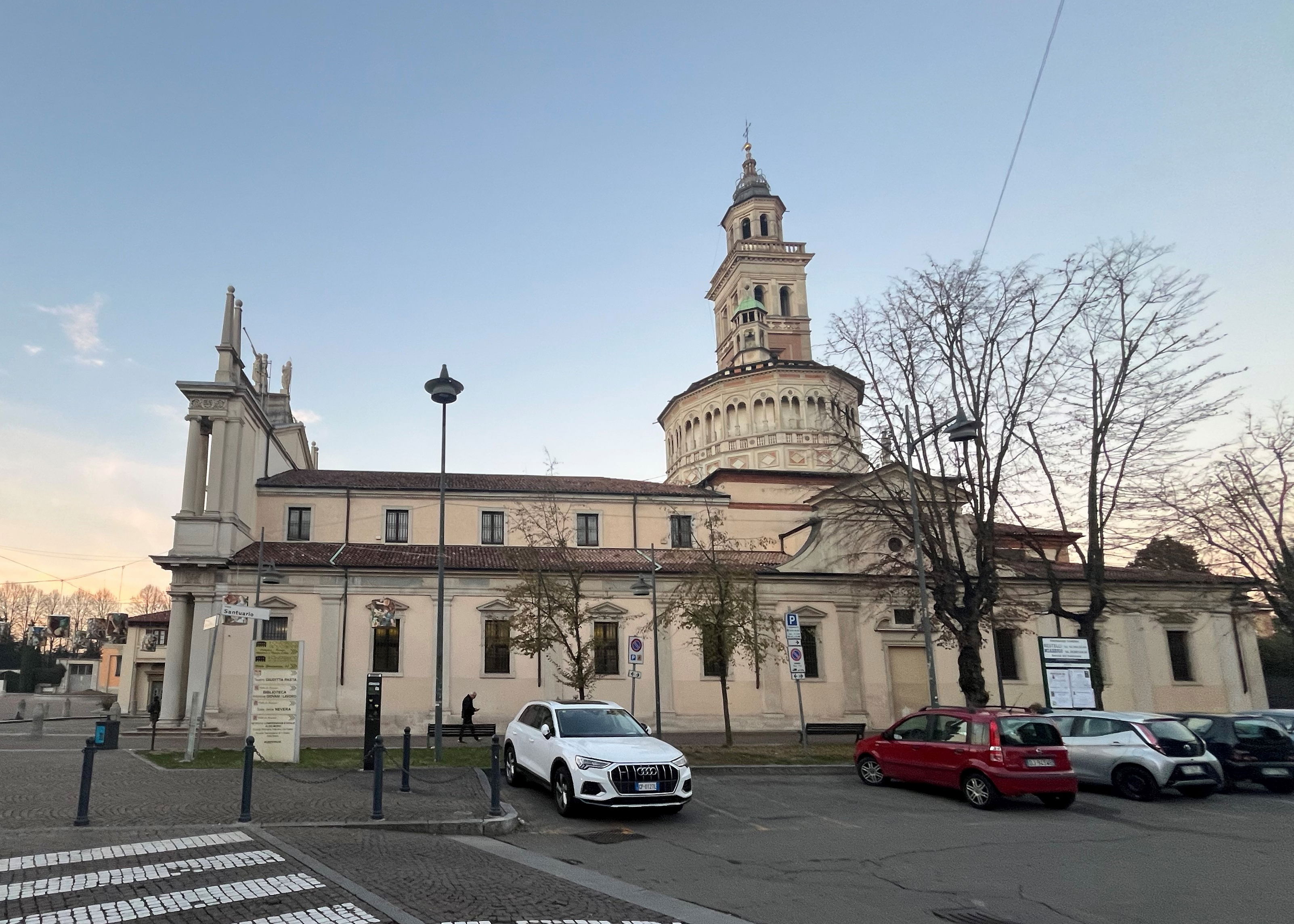
II Santuario della Vergine. Saronno
Saronno had its origins as the roman Solomnum, on the Via Mediolanum-Bilitio, ( Milan to Bellinzona) which connected Mediolanum (Milan) with Luganum (Lugano) passing through Varisium (Varese). The oldest documentary evidence of the existence of Saronno is a notarial charter of 796, Before arriving at the definitive name of Saronno, over the centuries the city was mentioned as Solomno , Serogno , Sorogno , Serono and Sarono.
On 8 May 1498 on the initiative of the Saronnese community, the construction of the Sanctuary began on the site where a chapel that had already collapsed three times was already standing. The chapel had become an object of special devotion because of the popular belief in the healing of a young man that took place, depending on the sources, in 1447, 1460 or 1497, and others that followed. Maybe it was a Christian attempt to re-interpret a sacred pagan place that probably already stood on the Strada Varesina- The document bearing the name of the architect who conceived the initial project of the sanctuary with a Latin cross plan, formed by the rooms of the apse, the presbytery, the ante-presbytery, the hall surmounted by the lantern and the dome and the two side chapels has not been found. The building was designed in the opposite direction compared to traditional medieval churches with a Latin cross, in order to emphasize the centrality of the vault as a circular structure under which the ecclesiastical community was gathered.
In 1507 the house of the "deputies" (the elective body in charge of supervising the administration of the sacred building) was built next to the sanctuary; Between 1511-16 the bell tower was raised, 47 meters high, designed by the architect Paolo della Porta, considered one of the most beautiful in Lombardy and taken as a model for numerous other churches. The exterior of the lantern has 24 elegant windows, determined by 12 mullioned windows corresponding to the dodecagonal drum that covers a dome of 8 sides generated by the insertion of four corner segments on an elevation founded on four corner pylons, according to the traditional ad quadratum construction scheme, according to a simple arithmetic progression (4+8+12 = 24) that develops from the bottom to the top, from the square of the hall to the circle of the dome, from Earth to Heaven. With a growing number of faithful the deputies of the Sanctuary decided to undertake an expansion project with the construction of a building with three naves spread over five bays. The new works began in 1556, but proceeded relatively slowly, by 1566 only three of the five planned bays were built, and the façade had a temporary arrangement. Carlo Borromeo restarted the building work, which involved demolishing the original "chapel of the Miracle". He personally officiated on September 19, 1581 when the original statue of the Madonna was moved into the sanctuary. The building still did not have a façade and noted architect Pellegrino Tibaldi, better known as Pellegrini, was called upon. Further construction lasted until 1613. The style adopted by Pellegrini was inspired by the classical canons of the late Renaissance, The richness of the ornamental motifs (with columns, pilasters, two large caryatids flanking the entrance portal, friezes, balustrades, statues in the high side niches, etc.) produces an architectural complex of great solemnity worthy of such an important church. .

Tibaldi's Facade - II Santuario della Vergine.
Such a beautiful church needed fitting internal decoration as well. In the 1520s, Bernardino Luini who was by then in his forties arrived in Saronno. Legend has it that he fled from Milan on account either of crime or political intrigue, and took refuge at Saronno, where he was forced by the monks to paint the frescoes in return for their sanctuary and hospitality. This story seems to be challenged by records stating that Luini was paid for some of his work, and also had freedom of artistic control over the frescoes. Other artists were employed at Saronno at the same time, including Lanini, Abbiati, and Gaudenzio Ferrari the latter of whom executed the wonderful fresco in the cupola in 1535.
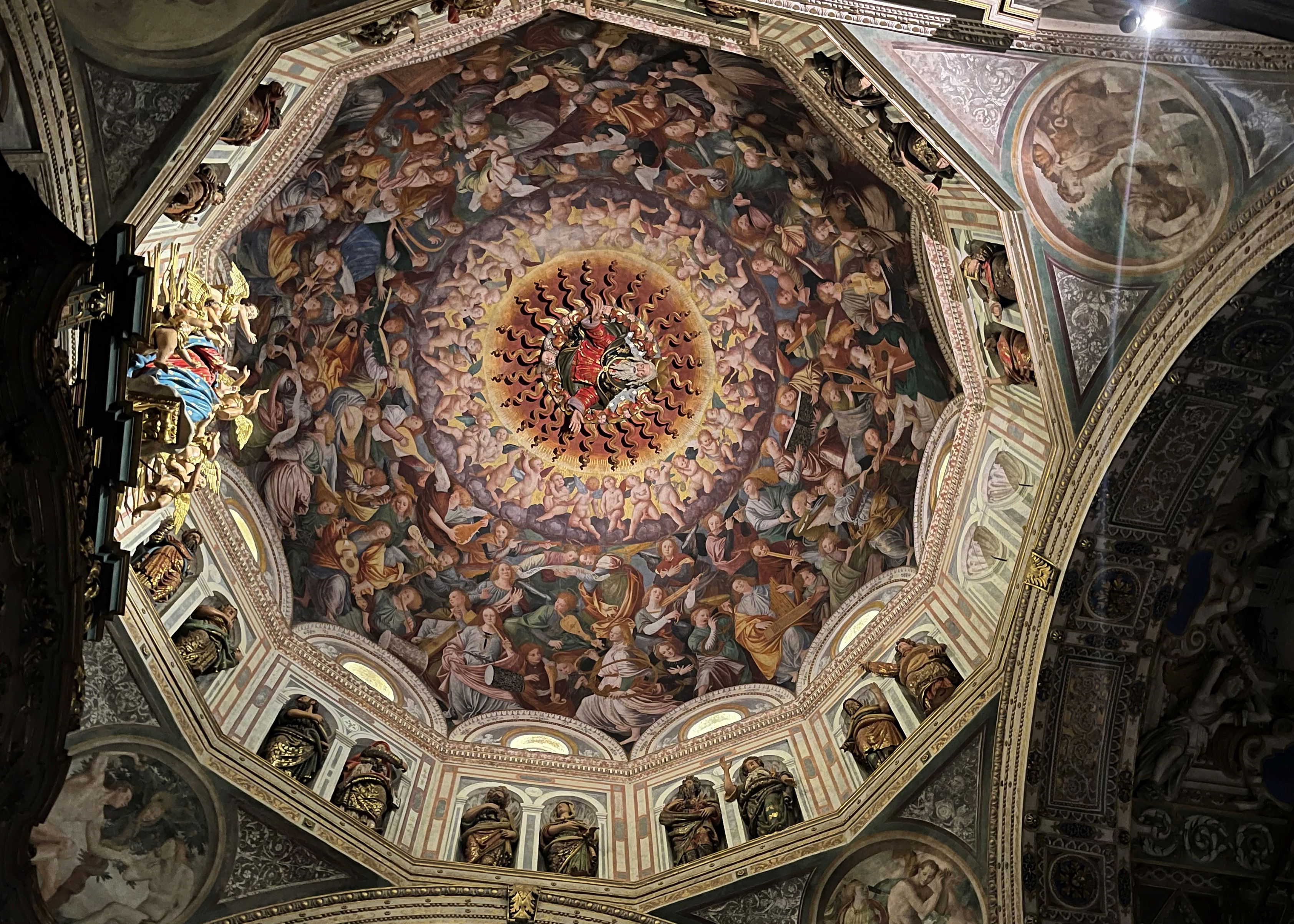
Gaudenzio Ferrari's superlative Cupola really catches the eye
Luini's work at Saronno consisted mainly of two large frescoes in the passage connecting the nave and choir, representing the “Marriage of Joseph and Mary” and “Christ Disputing with the Doctors”; and two more close to the high altar, “The Presentation in the Temple”, and opposite to it, “The Adoration of the Magi”. Additionally he executed the Saint Apollonia and Saint Catharine in the apse some Sibyls, Evangelists, and Fathers in the panels and lunettes, and a Nativity in the cloister leading to the priest's house.

"The Marriage of Our Lady". Fresco by Bernardino Luini
“The Marriage of Our Lady” depicts the marriage of the Virgin Mary and St Joseph. This ceremony is not mentioned in the canonical gospels, but was derived from apocryphal sources, namely the 14th Century Golden Legend. Giotto’s frescoes in the Scrovegni Chapel covers this in four scenes, , but the Renaissance the betrothal and the marriage were usually included in the same scene. The High Priest of the Temple gathered together all the male descendants of King David of marriageable age including Saint Joseph He ordered them exam to bring a rod and the one whose rod bore flowers would become Mary’s husband. One of the two unsuccessful suitors in the picture can be seen breaking his non - flowering rod , while Mary is married/ betrothed to Joseph. The woman next to Mary, is presumably Saint Anna
In his book on Luini , the British art historian George Charles Williamson highlights:
“The modest simplicity of the Madonna; the reverent thoughtfulness of St Joseph ; the tenderness of the High Priest ; the solemn faces, full of dignity, of the attendant priests ; the affection, mingled with regret, of the Virgin ; the regret, combined with full satisfaction in the justice of the decision, on the part of the rejected suitors ; the maternal anxiety of St Anna. All these characteristics are easily noted, and at the same time the honesty, the truth and human life of the whole scene is noteworthy.”
Williamson goes on to say it –
“is a picture which at once proves that Luini, even at his best, had not learned from Leonardo how to compose and group a picture. The separate figures are lovely, the fresco itself is lovely but when it is carefully examined its faults in construction are clear. All the heads are on one plane ; there is no atmosphere and no perspective in the picture. “
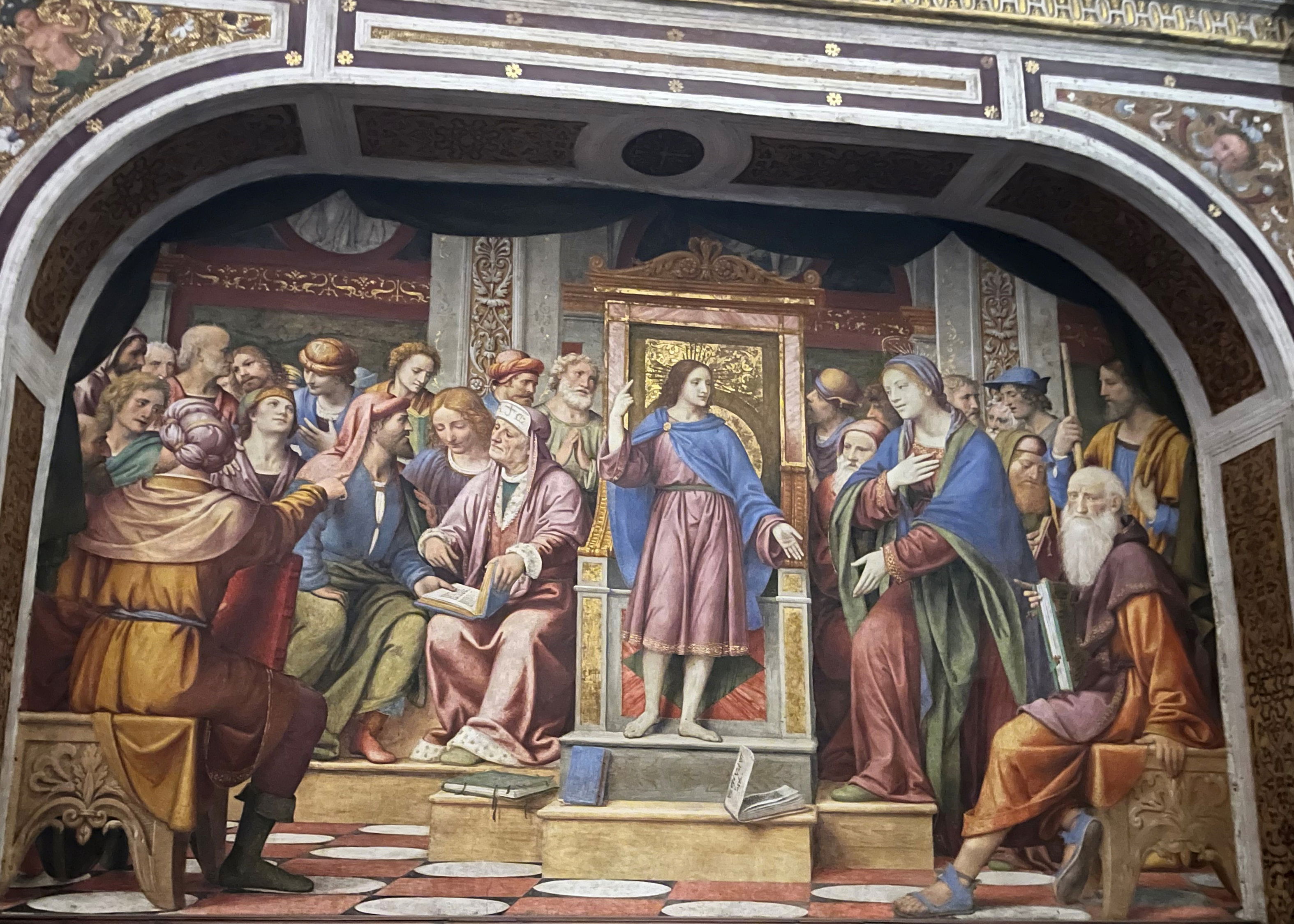
"Christ Disputing with the Doctors". Bernardino Luini
“Christ Disputing with the Doctors “(Disputatio) is a scene from the Bible ( Luke 2: 41-51) Jesus is standing in front of a raised chair of dignity made of marble. On the left is Mary, having evidently just entered, and in the act of expostulation with her son; behind her stands St Joseph with his staff in his hand, and nearby are two elders and four other men looking with curiosity upon the scene. Close at hand is a venerable figure with a long white beard, who is seated in the extreme comer, and is holding a clasped book. He has turned his wrinkled, serious face toward the spectator, Tradition points out as the representation of the painter himself. Since Luini was supposedly born in 1489 and was painting at Saronno in the 1520s, he does not appear to have aged particularly well. The doctors, appear as a vivacious, gesticulating, argumentative group. Their chief, to whom the others appeal, and who has the open Scriptures on his knees, wears an important phylactery, and is looking up in a state of bewilderment at the wisdom of the Christ. Jesus clad in a loose garment, circular at the neck, and bordered at both neck and sleeves with embroidery, and having a light outer robe thrown across his figure from one shoulder, is with one hand pointing upward, and his gesture of an out- stretched hand reminds Mary of his mission to the world. Every expression and gesture is full of spontaneous grace. The French art critic Alexis Francois Rio described the fresco.
" L'artiste a represent Jesus-Christ enfant au milieu des Docteurs : la pose, le geste, le regard, le mouvement de la figure principale, font presque deviner les paroles qui sortaient de cette bouche divine et peuvent servir de commentaire au texte de Sante Luc,- Stupebant autem omnes qui turn audiebant."
While the above two frescoes are long and narrow, the next two are upright and enclosed by arches, and they mark a still greater skill on the part of the artist.
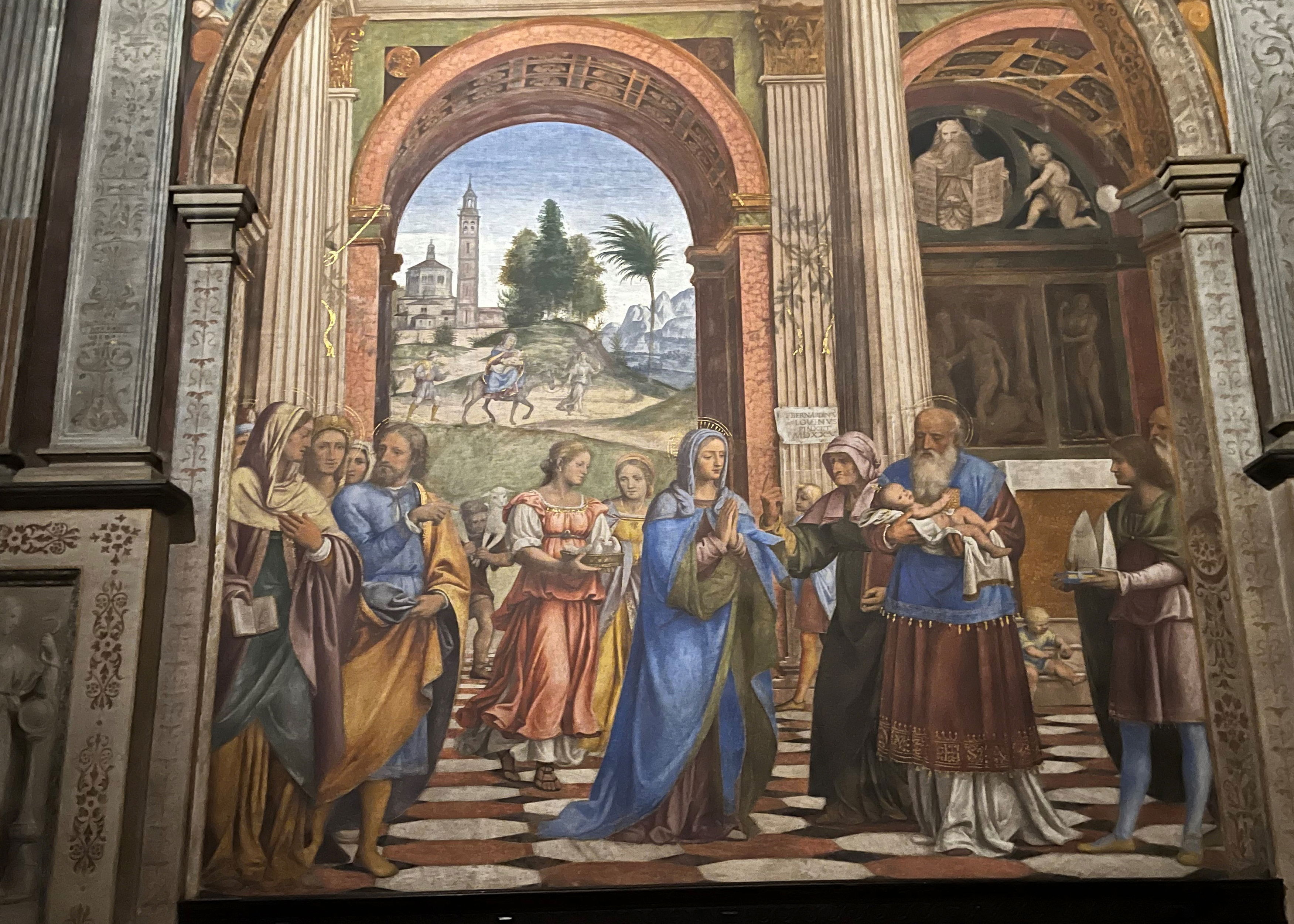
“The Presentation in the Temple”,- Bernardino Luini
In “The Presentation in the Temple”, the Madonna is the central figure, the Prophetess Anna stands close by, and Jesus is in the arms of the High Priest, near whom stands a boy bearing the mitre. Behind the Madonna are other women, with their children, and a boy with a lamb. On the extreme right St Joseph and the holy women are eagerly engaged in congratulatory conversation while St Joseph points out the Madonna to them.

Detail of the Flight into Egypt, the Church itself can be seen in the background
The scene is represented in a church with circular arches, and in the distance can be seen the Santuario della Beate Vergine, itself, and a representation on a minute scale of the flight into Egypt On a panel, depicted as being high up inside the church, is the old covenant, Moses with the law, and the great leader is represented looking down upon this fulfilment of law and prophecy. High up above in a gallery are angels watching the scene, while attached to one of the pilasters of the temple appears a paper label bearing the interesting signature, in plain square capital letters, BERNARDINVS LOVINVS PINXIT MLXXV.

Bernardino Luini painted this
The fourth fresco is “The Adoration of the Magi”. This subject was a very popular one in Milan because of the tradition that the Archbishop Eustorgius deposited in Milan the bodies of the three kings presented to him by the Emperor Constantine in a huge sarcophagus at St Eustorgio one of the oldest churches in the city. When Milan was besieged by Frederick Barbarossa, the citizens removed the relics from the church, which then stood without the city walls, but when the city fell Archbishop Rinaldus of Cologne carried them off to his home city where they can still be seen today.
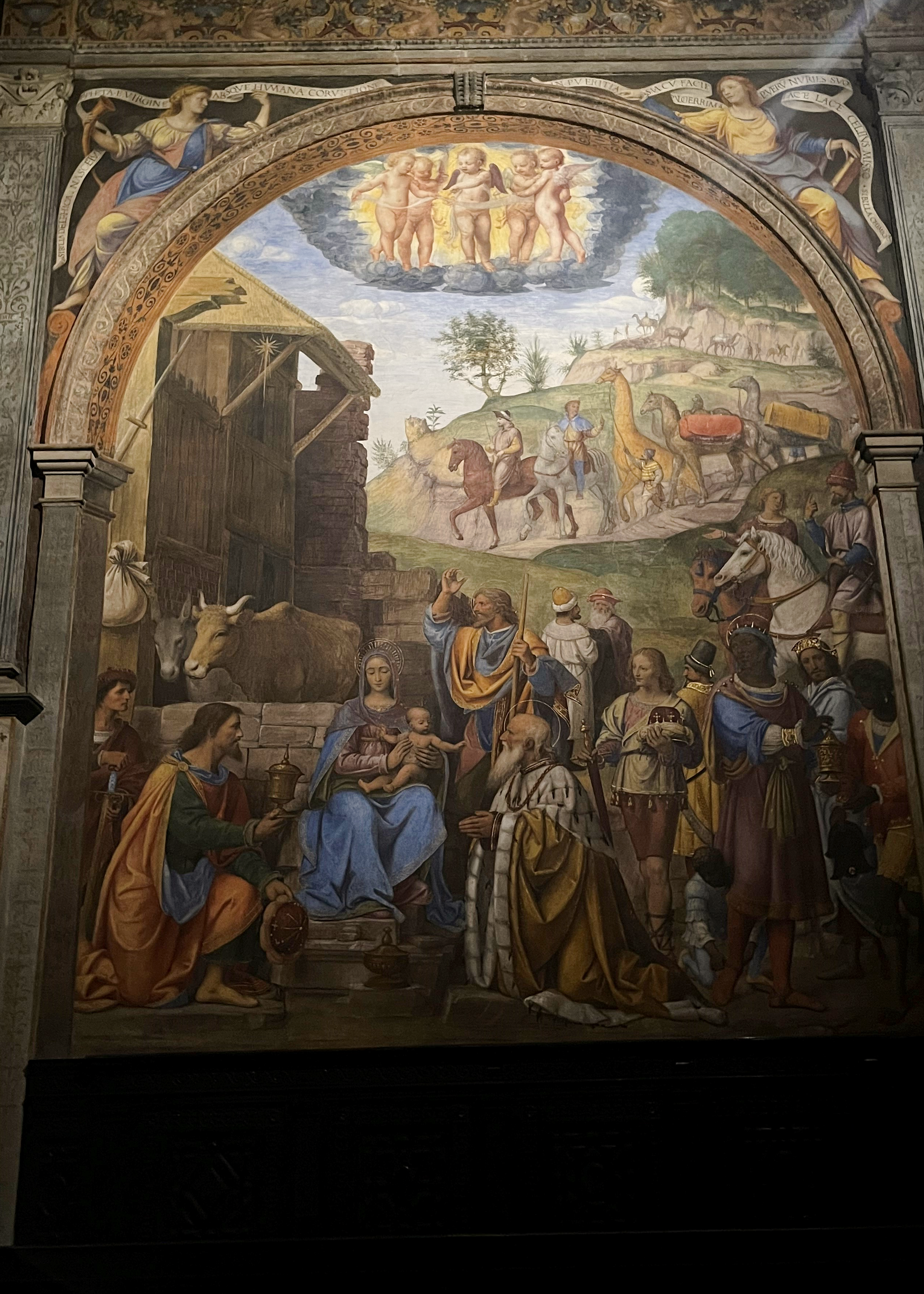
- The Adoration of the Magi Bernardino Luini
Luini returned on a number of occasions to the “Re Magi” One of the frescoes removed from San Martino in Greco Milanese which subsequently appeared in the Litta Collection in Milan and was then sold to the Louvre shows a similar scene.

Adoration of the Magi originally from the Oratorio of the Church of San Martino Greco Milanese now in the Louvre
The composition of the Saronno fresco is not dissimilar from the Louvre version, although the scene is out of doors. The Madonna is seated with the infant Jesus on her knee, he is partially clothed in a light garment and supported by his mother's hands. Jesus appears a bright and vivacious baby and is playfully stretching out a hand toward the king who kneels before him. In the Louvre fresco the venerable old king clad in ermine kneels before Jesus, having laid his gift at the feet of the Madonna,. Behind him is his attendant, bearing his sword and crown, and a little farther back stands a second king, who is in the act of receiving his gift of a golden vessel from his servant. In the Saronno fresco Balthazar and Melchior, appear clad in very similar garb to the representations in the Louvre. The third king, Caspar, is a very different person is by Saronno a very different person. All the faces in this striking fresco are far more spiritualized than the Louvre version and Caspar especially has now become a different man. He kneels on the right of the Madonna in a timid, half shrinking manner, nervously holding his turban or crown. It appears that he is conscious of the solemnity of the moment and of his own unworthiness, his sin, and his troubles. He is in the presence of the long-looked-for Messiah, and hardly dares to approach. The other faces all show the progress Luini has made since the Greco/ Louvre frescoes.. The kneeling king is full of reverence, and his attendant has a thoughtful but puzzled expression.
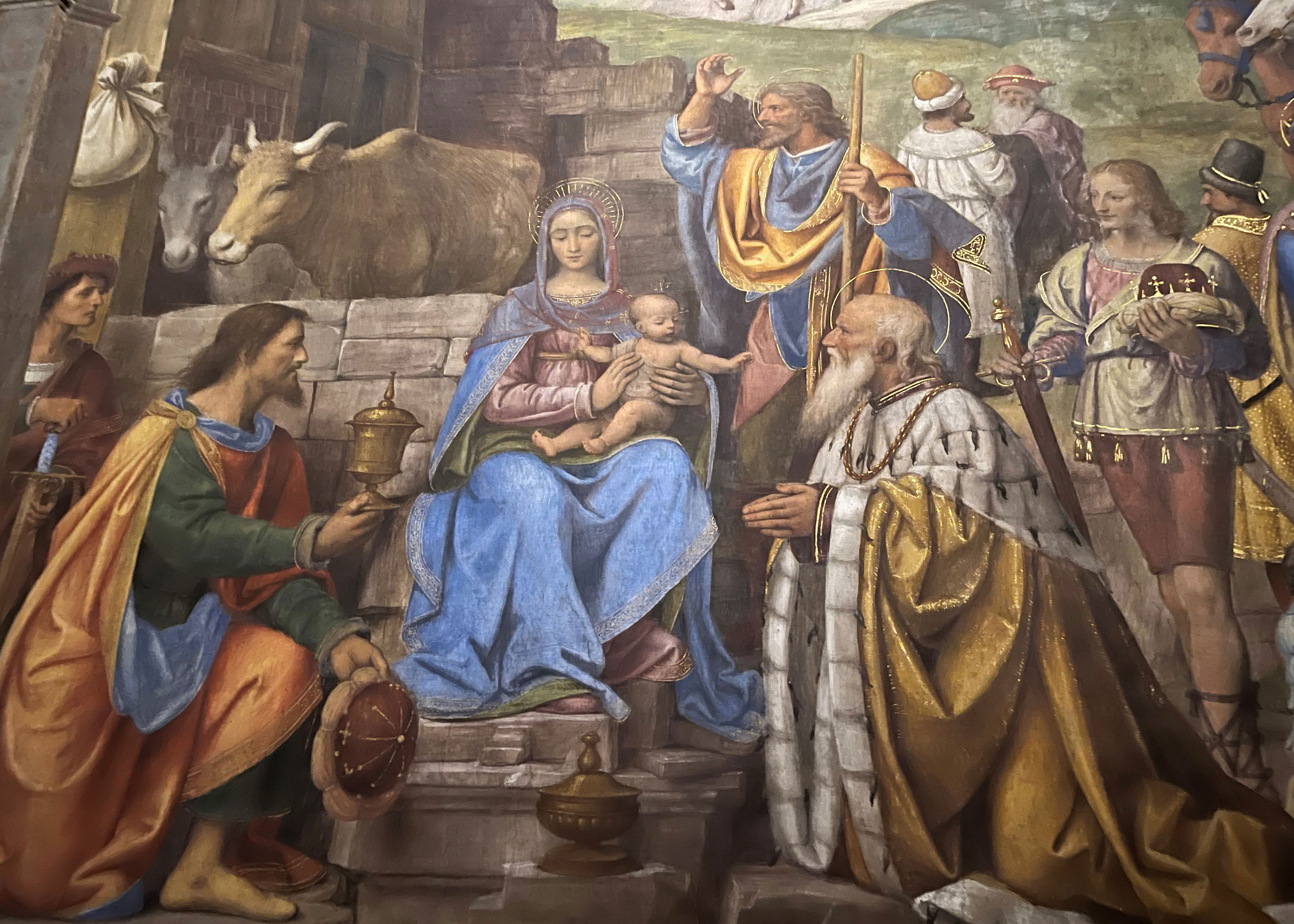
Balthazar representing Europe and Caspar representing Asia - from Bernardino Luini's "The Adoration of the Magi"
At Saronno , Luini follows a traditional composition of the scene. In Byzantine art , the Magi were traditionally depicted as Persians, wearing trousers and Phrygian hats ( soft conical caps associated with peoples of Eastern Europe, Anatolia and Persia) . By the 10th Century, these had often been replaced by crowns. After the very earliest representations of the scene, a traditional arrangement of the three figures was introduced which can be traced, more or less, in all Italian pictures. Beginning in the 12th Century and with increasing frequency by the 15th , the kings began to represent the three parts of the known world, Europe, Asia and Africa. ( although painted after 1492 so the Americas were not represented) Luini followed this conventional arrangement very closely. Balthazar kneeling has already removed his crown and presented his gift, he represents Europe having already embraced Christianity. His Crown is removed and held by the attendant being him who also holds his sword. Caspar representing Asia is in the act of removing his crown and presenting his gift, Asia being in a transitional state as to Christianity.

The third king, Melchior, is at a distance, on his way, certainly, but still some distance off, his crown still on his head, and his gift not yet presented; Africa, typified by this third king, was almost wholly unknown in Renaissance times. So Melchior remains aloof, with crown still on and an attendant holding his gift .Balthazar, closely resembles that which tradition has assumed to be the artist's own features as also seen St. Joseph, a grand figure seems to understand the mystery and raises his hand to God in thanksgiving. Behind the Madonna are the cattle, lowing in their open stable In the background is a long, winding train of attendants, with camels, horses, and a giraffe ; while above, differing in this respect altogether from the Louvre fresco, is a band of singing angels. These five cherubs are open-mouthed, singing with exultation the " Gloria in Excelsis " from a parchment scroll which they hold in their hands. The star seen in the east rests in mid-air by the stable roof. Compared with the Louvre version the Madonna appears to have more than a merely human peasant face ; there is a sweetness that fails expression in words, a tender compassion, an enduring love, and the pathos of approaching sorrow.
Luini also painted two female saints in the apse opening from the choir. The two figures stand in niches, the perspective and the shadows are cleverly arranged, and there is a not unpleasant effect of relief.
St Catharine holds a clasped book in one hand, and the other, holding a palm, rests upon her wheel of martyrdom. St Apollonia also bears a palm, and in her right hand the traditional pincers holding her tooth. Both figures are well drawn, the draperies easy and soft, the colouring rich but subdued.
There are more figures by Luini below the drum of the dome ; St Christopher, St Anthony, St. Sebastian, and St Roch,; life-sized, majestic figures, each attended by an angel who comes to present the palm of martyrdom and to assure the saint of an everlasting reward.

St Sebastian - Bernardino Luini
It is not surprising to find St Sebastian in Lombardy. According to the Golden Legeno, he was born in Narbonne in the South of France, but had been educated in Milan , where he was a favourite of the Roman Emperor Diocletian. During the Lombard era, Sebastian gained a reputation as a protector against plague. Before the Black Death , the plague had blighted Italy several times, notably the pandemic known as the Justinian plague. . Paul the Deacon, in his “History of the Lombards” mentions four separate outbreaks. Liguria in 565, Rome in 590, Ravenna, Grado and Istria in 593 and a final outbreak in Rome and Lombardy in 680. Following this last outbreak in Pavia, a local man had a vision that the epidemic would not cease until an altar to St Sebastian was set up at the Church of St Peter. The citizens of Pavia duly had some suitable relics of Sebastian sent up from Rome and set up the altar. Sure enough the plague ended. In art, St Sebastian is usually punctured by so many arrows, one would think they had killed him: However according to legend , he survived the arrows and the Emperor Diocletian had him beaten to death instead. So Lombard local hero Sebastian was blessed for his remarkable powers of recovery. Sebastian’s arrow wounds also began to be associated with the plague. Homer’s Iliad had introduced the idea of plague arrows. Apollo was angry with the Agamemnon and in retribution in an early example of biological warfare his arrows rained down pestilence on the Greeks. So by the early 16th Century, Sebastian had become famous for cheating death ( at least the once) ,his arrow wounds became associated with plague and resisting it.

St Sebastian survived his arrow wounds and was believed to ward off the Plague
St Roch also had connections with the plague. .As usual his life is not robustly documented ,but according to legend he was born in Montpellier around 1295 , had joined the Franciscan order and set out as a mendicant pilgrim to Rome. According to legend Roch had cured plague victims in Rome, Rimini and Lombardy before moving to Piacenza. There he had contracted the plague and gone off into the wilderness to die. He survived , thanks to a miraculous spring of water and a friendly dog who bought him bread to eat. So the iconography of St Roch is associated with a dog and apparently a bread roll. He is also usually shown with a rolled up trouser, revealing the plague buboes on his thigh. The Saronno picture has the friendly dog and a bread roll, St Roch is showing his thighs but the bubos is not particularly clear. Unfortunately according to tradition ,St Roch died in 1327 before the Black Death, so he might well have survived something else. Subsequent adjustments to his timeline try to place him as alive during the Black Death. The cult of St Roch began to gain traction during an outbreak of bubonic plague in Northern Italy in 1477-79. Although In the 1520s, Northern Itay was enjoying a break from plague, it would make a devastating return in the 1620s. The plague was never far away. The association of Saints Sebastian and Roch with the plague would have been recognisable even to the illiterate folk of 16th Century Saronno .However the paintings were not just there for decoration, the locals would have been prepared to make donations to the church, which was already famed for the healing Virgin to ward off the dreaded plague.
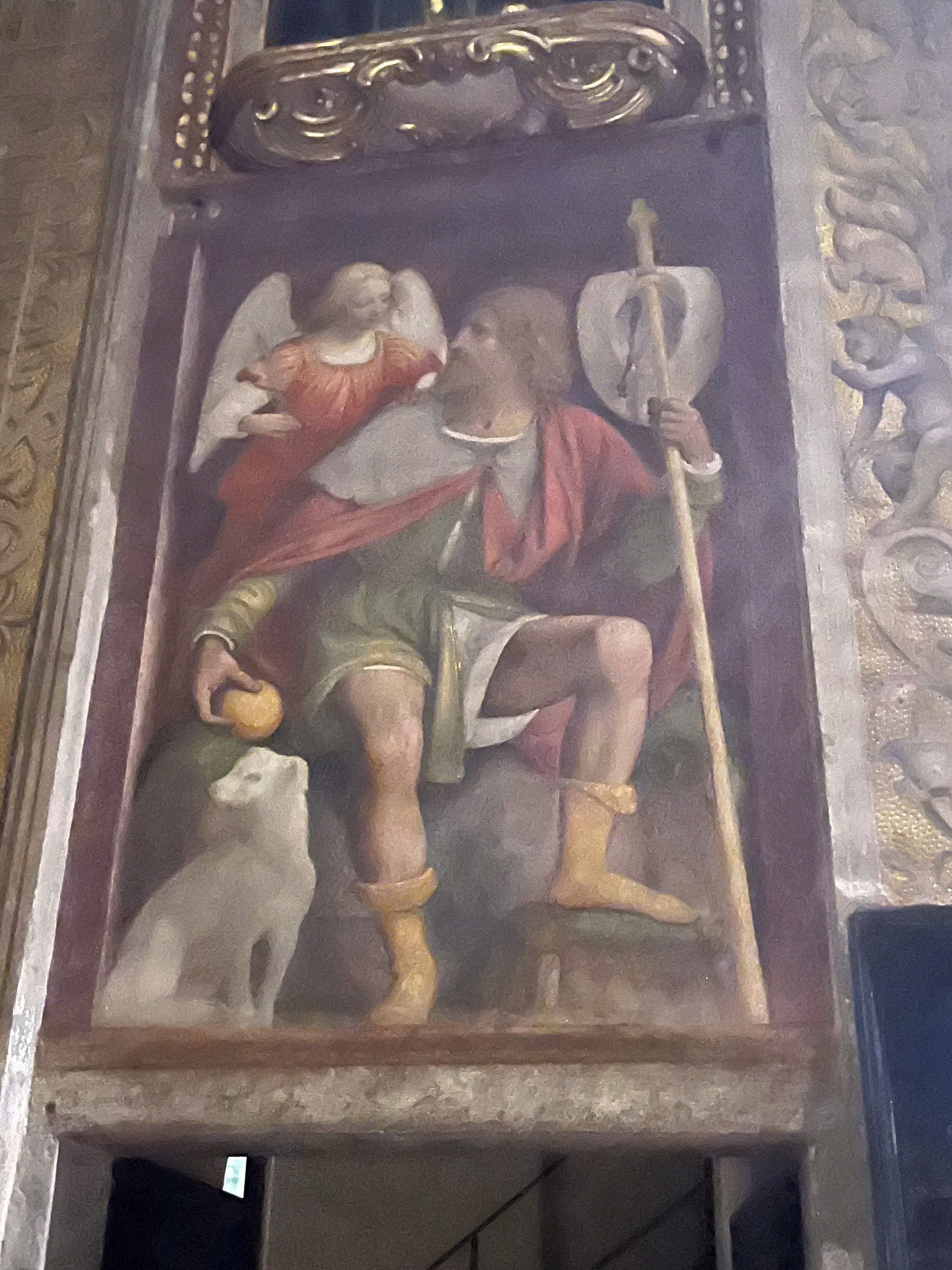
Next we come to St Anthony and the curious question of why he was accompanied by a pig. Anthony was supposedly born in Koma in Lower Egypt to wealthy landowner parents. When he was about 20 years old, his parents died and left him with the care of his unmarried sister. Shortly thereafter, he decided to follow the gospel exhortation in Matthew 19: 21, "If you want to be perfect, go, sell what you have and give to the poor, and you will have treasures in heaven." Anthony gave away some of his family's lands to his neighbours, sold the remaining property, and donated the funds to the poor, placed his sister with a group of Christian virgins and went off to live a monastic life. For the next fifteen years, he remained in the area, spending the first years as the disciple of another local hermit. There are various legends that he worked as a swineherd during this period ( hence one of the pig connections) According to Athanasius, the devil fought Anthony by afflicting him with boredom, laziness, and the phantoms of women, which he overcame by the power of prayer,. After that, he moved to one of the tombs near his native village. After fifteen years of this life, at the age of thirty-five, Anthony determined to withdraw from the habitations of men and retire in absolute solitude. He went into the desert to a mountain near the Nile There he lived strictly enclosed in an old abandoned Roman fort for some 20 years. Food was thrown to him over the wall. He was at times visited by pilgrims, whom he refused to see; but gradually a number of would-be disciples established themselves in caves and in huts around the mountain. Thus, a colony of ascetics was formed, looking to Anthony as their guide in the spiritual life. Eventually he emerged from his retreat apparently looking none the worse for his ordeal. The pig, regarded as symbol of gluttony maty also indicate st Anthony's resistance to that vice through his ascetic lifestyle.
Anthony is credited with assisting in a number of miraculous healings, primarily from ergotism, which became known as "St. Anthony's Fire". He was credited by two local noblemen of assisting them in recovery from the disease. They then founded the Hospital Brothers of St. Anthony in honor of him, who specialized in nursing the victims of skin diseases , so he is appealed to against infectious diseases, particularly skin diseases, Again in times of pestilence intercessions were frequently made to Sst Anthony.
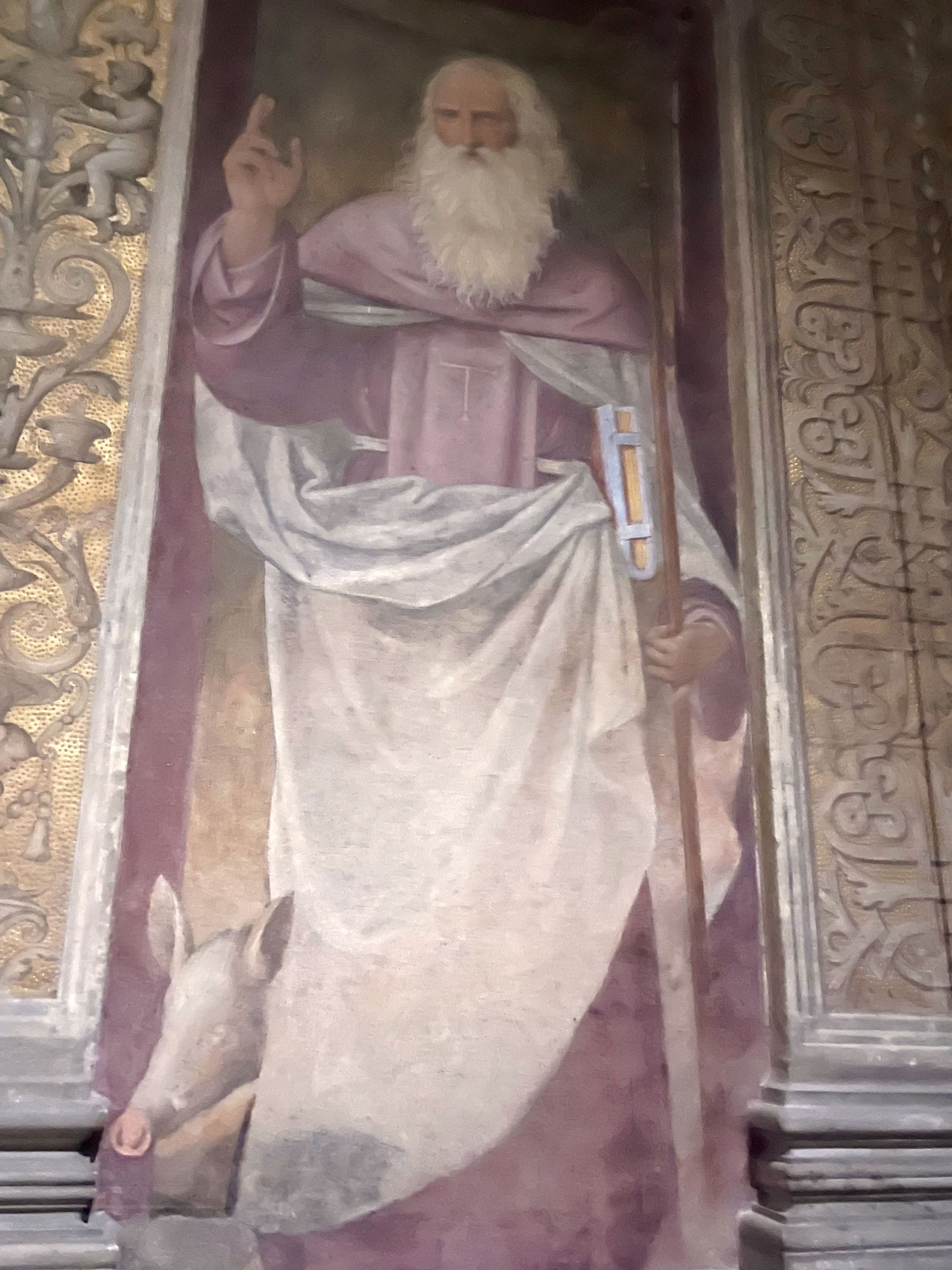
St Anthony - Bernardino Luini- the pig may indicate his fabled career as a swineherd or his resistance to the vice of gluttony
Epics about the life and death of Saint Christopher first appeared in Greece in the 6th century and had spread to France by the 9th century. The most popular variations originated from the Golden Legend. According to the legendary account of his life Christopher was initially called Reprobus. He was a very tall Canaanite, (allegedly 7.5 feet (2.3 m)) and with a fearsome face. While serving the king of Canaan, he determined to serve "the greatest king there was". He went to the king who was reputed to be the greatest, but saw the king cross himself at the mention of the devil. On learning the king feared the devil, Christopher went off to look for the devil. He came across a band of marauders, one of whom declared himself to be the devil, so Christopher decided to serve him. When he saw his new master avoid a wayside cross and found out that the devil feared Christ, he decided to follow him instead. . He met a hermit who instructed him in the Christian faith. Christopher asked him how he could serve Christ. When Christopher rejected fasting, the hermit suggested that because of his size and strength he could serve Christ by assisting people to cross a dangerous river. After Christopher had performed this service for some time, a little child asked him to take him across the river. During the crossing, the river became swollen, and the child seemed as heavy as lead, so much that Christopher could scarcely carry him and found himself in great difficulty. When he finally reached the other side, he said to the child: "You have put me in the greatest danger. I do not think the whole world could have been as heavy on my shoulders as you were." The child replied: "You had on your shoulders not only the whole world but Him who made it. I am Christ your king, whom you are serving by this work." The child then vanished. After this Christopher visited Lycia and comforted local Christians who were being martyred. Brought before the local king, he refused to sacrifice to the pagan gods. The king tried to win him by riches and by sending two beautiful women to tempt him. Christopher converted the women to Christianity, as he had already converted thousands in the city. The king ordered him to be killed. Various attempts failed, but finally Christopher was beheaded- The huge figure of Christopher with one foot in the water, and the infant Jesus on his shoulders would have been instantly recognisable to the faithful. Presumably as the patron saint of travellers would have received some intercessions from travellers on the way from Milan to Lugano.
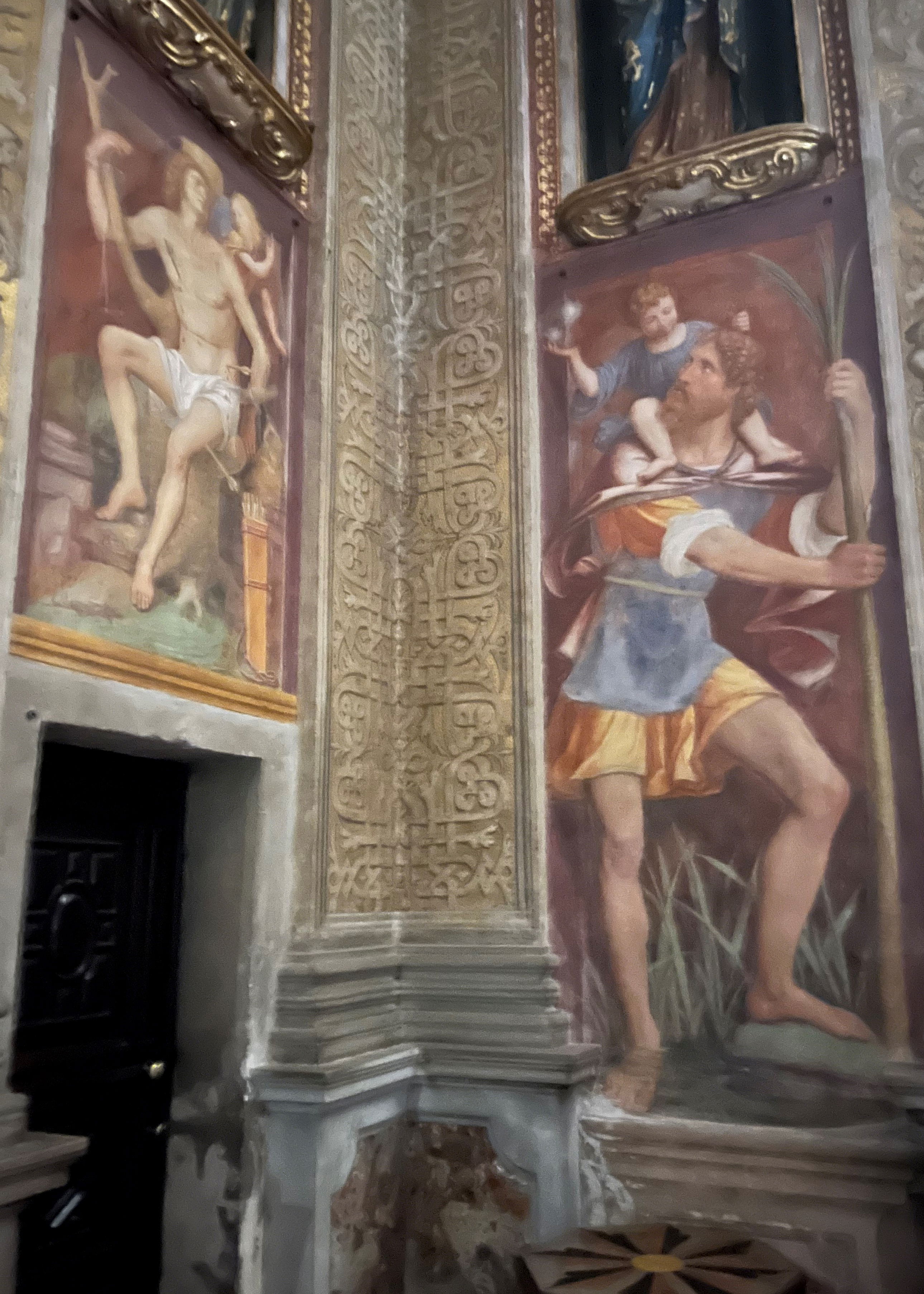
St Christopher - Bernardino Luini. He is indicated by his staff, the river crossing and the infant Jesus on his shoulders. Presumably a welcome sight for travellers on the road from Milan to Bellinzona
Finally, on the cloister wall, on the way to the priest's house, is the well-known lunette of the Nativity. This was, it is said, painted by Luini freely, as a gift to the monks expressive of his pleasure at the treatment he received at their hands. The precious Nativity, so carefully covered with glass on the cloister wall, represents the Madonna and St Joseph kneeling in adoration before the Infant Christ . The scene is a stable, the cattle are behind Him, and from the doorway can be seen the shepherds tending their flocks, and the angel announcing the Divine n to them. Below, and nearer to the stable,.is another piece of symbolic teaching, the Shepherd returning, bearing on His shoulders the sheep that had been lost. The reverent air of St Joseph, the tender love of the Virgin are expressed in a most subtle manner, the com- position is perfect, and the lunette one of the loveliest works that Luini ever did, rivalling the more celebrated lunette at Lugano.
As well as Luini's frescoes well worth a look at the beautiful carving of the last supper . If Milan has Leonardo's Cenacolo, then Saronno has the ultimate 3D version , a beautiful carving by Andrea di Corbetta , with decorations by Alberto Meleguli da Lodi and a background by Camillo Proccacini.

The sublime 3D last supper in Saronno
Luini received 18 lire each for the single figures, together with lodging, food, and wine, and is said to have been paid for the picture frescoes at the rate of 30 soldi per day.
Having finished at Saronno Luini probably, returned to Milan {circa 1524-1526) and commenced his most elaborate and important scheme of interior decoration, for the church of San Maurizio attached to the monastery of nuns.
The Santuario Beata Vergine dei Miracoli in Saronno is about 10 minutes walk from Saronno station. Saronno is easily accessible from Milan and Monza by Trenord and the Malpensa Express.. Trains about every half an hour.
Bernardino Luini by George Charles Williamson can be read on the Internet Archive